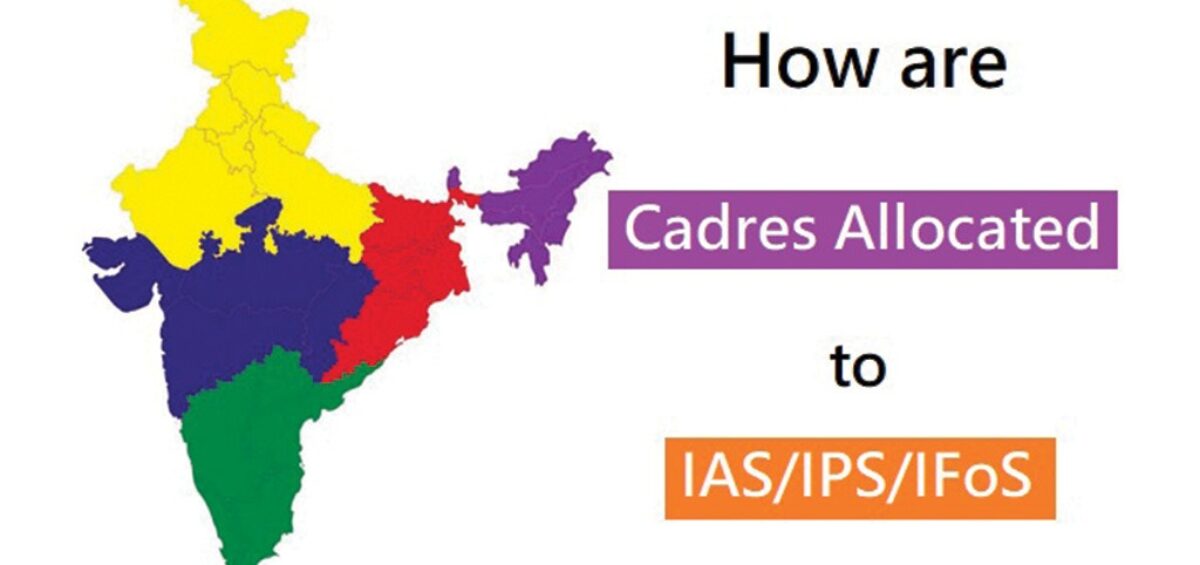What is a Cadre?
A cadre is a state or a group of states where an officer of an All India Services (IAS, IPS, IFoS) is posted. An IAS or IPS officer is posted in a particular cadre and works there until he opts for Central Government deputation. A cadre is allocated to a candidate by the Department of Personnel and Training (DoPT), Government of India. Allocation of cadre depends on the candidate’s rank, cadre-preference, and vacancies.
A brief history of cadre policy
Below is the transformation of cadre policies in table
[table id=1 /]
- New Cadre Policy, 2017
There are a total 26 cadres in India. These 26 cadres have been divided into 5 zones for the posting of IAS,IPS and IFoS officers. The zones along with the cadre is given in the following table
[table id=2 /]
A candidate can only select one cadre from each zone as their first choice. Their second choice will have to be from a different zone. For example, if a candidate selects Gujarat in zone 3 as his first choice, his second choice has to be from other zones. This simply means he cannot select Maharashtra, Madhya Pradesh or Chhattisgarh as their second choice.
How to select the Cadres according to the new cadre policy
- The candidates shall first give their choice in the descending order of preference from amongst the various Zones. The candidates will indicate one preference of two cadres from each preferred zone.
- The candidates will indicate their second cadre preference for every preferred zone thereafter. Similar process will continue till a preference for all the cadres is indicated by the candidate.
- It is to be noted that preference for the zones will remain in the same order and no change in the order of preference for the zones/cadres will be permitted.
- If a candidate does not give any preference for any of the Zones/Cadres, it will be presumed that he has no specific preference for those Zones/cadres. Accordingly, if he is not allocated to any one of the cadres for which he has indicated the preference, he shall be allotted along with other such candidates in the order of rank to any of the remaining cadres, arranged in an alphabetical order, in which there are vacancies in his category after allocation of all the candidates who can be allotted to cadres in accordance with their preference.
- A physically handicapped candidate has an option to indicate his preference for any one state/cadre of his first preferred zone. If he is found eligible as a Physically disabled candidate and accordingly he has been allocated to any of the All India Service, then he shall be allocated to that cadre as per the modalities.
- A reserved category candidate selected on general merit standards shall be eligible for allocation against the available unreserved vacancy as per his merit and preference. But if he cannot be allocated against such vacancy, for he is lower in rank as compared with other general category candidates, he shall be considered for allocation as per his merit and preference against the available vacancy of his category.
How to select the cadres to get Home Cadre
A candidate shall be allotted to his Home cadre, on the basis of his merit, preference and vacancy available at his turn in his category. For allocation to Home cadre against an Insider vacancy, a candidate will be required to express his first preference to the Zone in which his Home cadre falls as well as first preference to the Home cadre within that relevant Zone, otherwise he shall not be considered for his Home cadre at all.
For example, if a candidate belongs to Uttar Pradesh and he wants to serve in his home state, he will have to select Zone 2(as Uttar Pradesh is in zone 2) in their first preference. Within this zone, he will have to put Uttar Pradesh in the first place.
The cadre allocation process consists of three stages. They are as follows
- First, all those candidates who can be allocated against the Insider vacancies available in their category would be so allocated.
- Second, the candidates who are eligible for allocation to their Home cadre will be allocated first.
- Finally, the allocation against Outsider vacancies (including the Outsider vacancies, which remained eventually unfilled after the allocation) would commence.
How is the new cadre policy different from the previous cadre policies?
Before 2017, a candidate had the high possibility of getting posted in his home states or neighbouring states. If we compare the policies from 1966, we will find some lacunas that each and every policies were bearing. The policy that was in force from 1966 to 1977 did not give the candidate any opportunity to choose cadres of their choice. Even after scoring good marks, it was not sure for him to get to serve in his home state or neighbouring state.
After 1977, zones were created. But candidates have the option to select any two states from the same zone. This was hampering the sole purpose of All India Service. Most of the candidates were getting the opportunity to serve either in his home state or neighbouring states.
But the new policy of 2017 ensures a balance between candidate’s interest and national interest. In this new policy, there is a special provision for physically challenged candidates to offer them posting in or near their home states by adding additional preference in the list.
However, after the new cadre policy, selected candidates can be allocated to cadres far away. By doing this, the Government of India hopes for better national integration.

